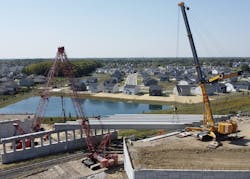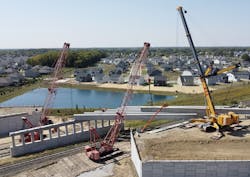Presidential Summit
It was a summit meeting of presidential proportions when three cranes worked together on the Ronald Reagan Parkway expansion just outside Indianapolis. Two lattice-boom crawlers and one all terrain (AT) crane (which topped out at an impressive 900-ton capacity) convened for a series of double and triple picks. On the agenda was setting 22 precast concrete bridge beams for two spans over railroad tracks.
Bringing these titans together required six months of planning as reps from Central Rent-A-Crane, a member of the ALL Family of Companies, and engineers from White Construction worked together to meticulously plot every move. Of particular importance in these early days was balancing strict capacity requirements, restricted lift radii, and delicate ground bearing pressures due to nearby underground utilities.
To set the 11 beams for the northbound bridge span, the AT, a Liebherr LTM 1750-9.1, set up on the north abutment while two 300-ton class crawlers, a Manitowoc 2250 and Manitowoc MLC300, set up on the ground below.
A unique aspect of these lifts was that the flatbed trailer carrying the beams was in motion as some picks began. Because there wasn’t room to put the beam on the ground first, one crane would connect to the rear of the beam while it was still on the trailer. The truck would then back up in rhythm with the swing of the crane until the other end of the beam was close enough for a “hand-off,” in which a second crane took hold of the back end of the beam while the first crane swung forward to the front of it.
“We picked the back of the beam, and as the crane swung over, we backed the truck up to get it close enough to do the handoff,” said Tim Welty, sales representative with Central Ret-A-Crane.
A rigging triangle was used to achieve the handoff. “We had one crane hooked to the triangle, which was straight up and down above the picking lugs,” said Welty. “The triangle point was sticking out the side toward the other crane, which hooked to the rigging to transfer the load to this second crane.” At that point, the first crane unhooked from triangle, swung over and grabbed the front of the beam.
The effect was a hand-over-hand motion that saw the beam extruded onto the bridge pier.
Some lifts required all three cranes, depending on lifting capacities at certain radii. Although two cranes had plenty of power, rules for lifting over railroad tracks require reduced loads on each crane. Splitting the load among three cranes brought the weights within the allotted range.
The AT was configured with 143 feet of main boom, Y-guy added to boost capacity, and 369,200 pounds of counterweight. The Manitowoc 2250 had the same counterweight and 130 feet of main boom, while the MLC300 had 137 feet of main boom and 397,400 pounds of counterweight.
After spending two days setting beams for the northbound span, the Central crew spent a day disassembling the 2250 to move it and re-assemble at the south abutment. The MLC300 remained in place at the center pier and the AT moved onto another job. The remaining 11 beams were set by the two crawlers. Because of smaller radii, splitting the load between two cranes still stayed within the railroad’s load requirements.
About ALL
The ALL Family of Companies is the largest privately held crane rental and sales operation in North America, operating under the ALL, ALT, Central, Dawes, and Jeffers names. For a rental quote: 800-232-4100 or www.allcrane.com.

